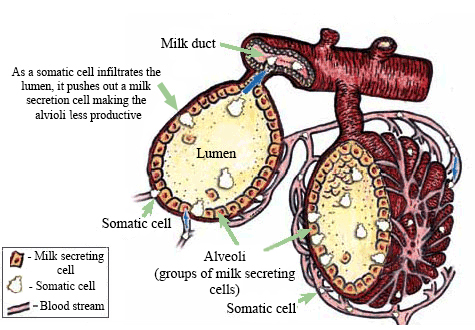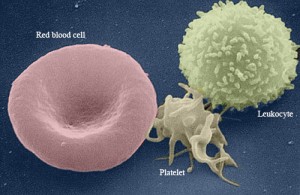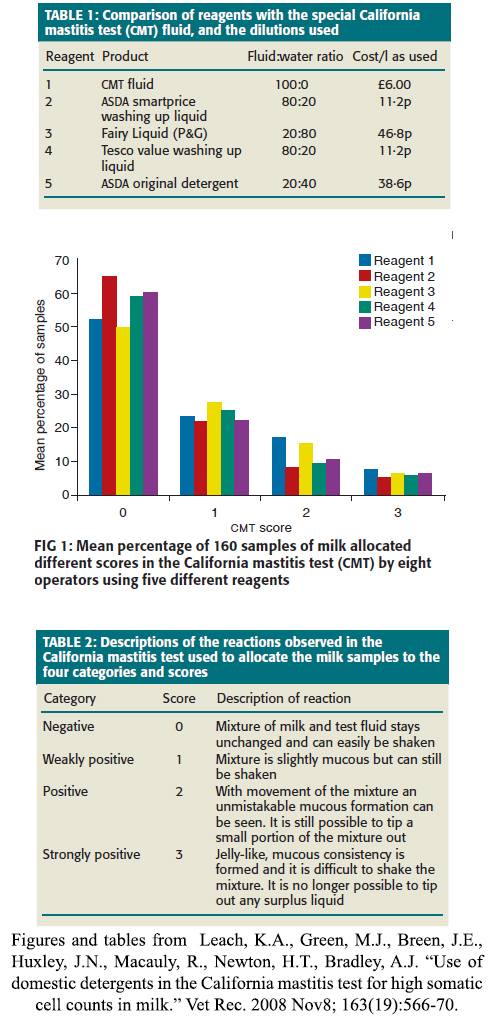The Basics of Somatic Cell Counts and What They Mean
What is a somatic cell count?
Somatic cell count (SCC) is the number of somatic cells found in a millilitre of milk. Somatic cells (or “body” cells) are a mixture of milk-producing cells shed from the udder tissue (about 2%) and cells from the immune system (the other 98%), known as leukocytes (also called white blood cells). Somatic cell counts are useful in identifying intramammary infection in an individual cow or herd. To understand a bit more about the cells and why they are found in milk we need to understand the function of leukocytes a bit better.
What is a leukocyte (or white blood cell) and why are they important?
Leukocytes are the cells responsible for identifying bacteria and killing them. Bacteria and other harmful pathogens enter the body in many different ways which is why these cells circulate through the body and make their way into different tissues. Just as nutrients are transported from the bloodstream into the udder to be converted into milk, leukocytes are also transported into the udder as a surveillance mechanism to look for bacteria which is why SCC levels are never zero.
Think of these cells as a night watchman at a museum. Unless there is absolutely no chance for crime, you will always have 1 night watchman. If crime in the community increases, you may have to hire a few more guards. If one of the night watchmen sees someone is breaking in and sounds the alarm, you’ll have not only all of the night watchmen running in, but also a large number of Gardaí entering the museum to catch and get rid of the thieves. The same thing happens with leukocytes and infections. Leukocytes are always circulating because we are always under threat of infection. If one of the leukocytes on routine surveillance runs into some bad bacteria, they will signal to the rest of the leukocytes and other immune cells that there is a problem, so they rush to the area of infection-hence the SCC in the milk will increase.
What happens when leukocytes infiltrate the udder during an infection?

When lots of leukocytes move to the udder during infection, this results in an increase in SCC and a decrease in milk yield. The udder is made up of millions of groups of milk-producing cells, collectively called alveoli. Within the alveoli is the lumen where milk accumulates until it can be transported through the milk ducts and expressed through the teat. When an animal has an infection in the udder, leukocytes infiltrate the alveoli by breaking through the tight junctions between and knocking out milk-producing cells, to get to the area where the bacteria grow. This damage to the milk-producing cells, and to the junctions between them, means the cow will produce less milk.
Is there an on farm SCC test that can be used to check individual cows?
California mastitis test kit, with CMT fluid, a 4-well paddle and dropper for adding CMT fluid
A quick and easy test available for on-farm use is the California Mastitis Test, or CMT. This test will not give you a specific SCC, but will give a positive result once a cow’s SCC goes over approx 400,000 cells/mL. A quick video to show you how to do a CMT can be viewed here.
How does the CMT work?
When you add CMT solution to milk and swirl it around, samples with a high number of leukocytes/white blood cells become mucous like. This reaction is due to the cells releasing DNA when the CMT solution breaks open the cells.Click here to see how and why the CMT works!
In 2008 researchers looked into the use of commercial detergents to use in place of the CMT solution. Their study looked at a variety of different store bought liquid detergents and found that the Fairy name brand detergent worked best over Tesco brand and a few other store brand detergents, so for your best chance of getting a good answer you must use real Fairy liquid. When Fairy liquid detergent was diluted with water, it worked nearly as well as the CMT solution for identifying samples with a high SCC. Click here for the instructions for Making your own CMT fluid.
Do I need to collect individual cow SCCs or can I always just use a sample from the bulk milk tank?
It is not imperative to collect individual SCC’s every milking, but collecting individual cow SCCs periodically, will help you to identify infected cows that are not showing any visible signs i.e. subclinical infections. Individual cow SCCs will also help you make management decisions such as whether or not to cull a chronically infected cow or deciding on dry cow treatment. Think of it like a game of hurling-the bulk tank SCC is the final score, while the players’ stats (=the individual cow SCC), tell you how each player performed on the day, and what they contributed to the game and the final score.
Are there factors other than infection that can influence SCC?
Stress may increase SCC levels slightly in cows, but the greatest increases are seen in infected
cows. Elevated individual cow SCC levels which are not associated with infection may occur for up to 20 days after calving. Elevated SCC levels may also occur in late lactation when milk volume is low and cells are ‘concentrated’. However, in uninfected quarters this elevation is minimal.
The concentration of cells in the milk varies throughout a milking, so the sample used to measure individual cow SCC should be collected throughout the milking. The concentration also varies between morning and evening milkings, especially with unequal milking intervals. Evening milkings tend to be higher.- This paragraph is directly from AHI’s CellCheck Farm Guidelines a very useful tool to have on hand. Click here for the link to get your own!
I would like to extend a special thanks to Finola McCoy of AHI for all of her help with this article.- J.McClure- [email protected]


